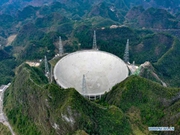

The China National Space Administration (CNSA) on Thursday, March 4, published high-resolution images of Mars captured by the country’s Tianwen-1 probe.
These images include two panchromatic images and one color image, said the CNSA. The panchromatic images were taken by the high-resolution camera of Tianwen-1 at a distance of 330 to 350 km above the surface of Mars, with a resolution of about 0.7 meters.
In the images, Martian landforms such as small craters, mountain ridges and dunes are clearly visible. It is estimated that the diameter of the largest impact crater in the images is around 620 meters.
The color image is of the red planet’s North Pole region taken by the medium-resolution camera, the CNSA said.
The high-resolution camera, medium-resolution camera, spectrometer and other scientific apparatus onboard the orbiter were switched on successively to collect data.
The medium-resolution camera is capable of both automatic exposure and remote-control exposure, enabling it to map remote-sensing images of the whole globe of Mars and to survey the planet’s topography.
The probe will survey the topography of the pre-selected landing area and conduct weather observation along the flight routes to avoid dust when landing on Mars in May or June, said Bao Weimin, director of the Committee of Science and Technology under the China Aerospace Science and Technology Corporation.
Nearly 50 Mars missions have been launched globally, but approximately two-thirds have failed, said Bao, who is also a member of the 13th National Committee of the Chinese People’s Political Consultative Conference, the country’s top political advisory body, adding that although China’s Mars exploration began late, the probe is designed to be highly efficient and innovative, aiming to complete orbiting, landing and roving operations in one mission.
China launched Tianwen-1 on July 23, 2020. The spacecraft, consisting of an orbiter, a lander and a rover, entered the parking orbit around Mars after performing an orbital maneuver on Feb. 24. Tianwen-1 probe has been conducting scientific surveys since Feb. 26.
 |  |

 Award-winning photos show poverty reduction achievements in NE China's Jilin province
Award-winning photos show poverty reduction achievements in NE China's Jilin province People dance to greet advent of New Year in Ameiqituo Town, Guizhou
People dance to greet advent of New Year in Ameiqituo Town, Guizhou Fire brigade in Shanghai holds group wedding
Fire brigade in Shanghai holds group wedding Tourists enjoy ice sculptures in Datan Town, north China
Tourists enjoy ice sculptures in Datan Town, north China Sunset scenery of Dayan Pagoda in Xi'an
Sunset scenery of Dayan Pagoda in Xi'an Tourists have fun at scenic spot in Nanlong Town, NW China
Tourists have fun at scenic spot in Nanlong Town, NW China Harbin attracts tourists by making best use of ice in winter
Harbin attracts tourists by making best use of ice in winter In pics: FIS Alpine Ski Women's World Cup Slalom
In pics: FIS Alpine Ski Women's World Cup Slalom Black-necked cranes rest at reservoir in Lhunzhub County, Lhasa
Black-necked cranes rest at reservoir in Lhunzhub County, Lhasa China's FAST telescope will be available to foreign scientists in April
China's FAST telescope will be available to foreign scientists in April